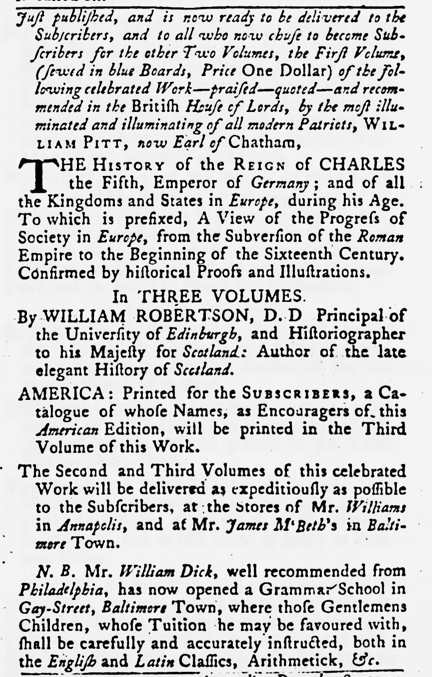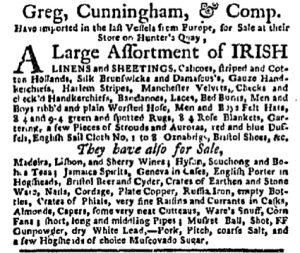What was advertised in a colonial American newspaper 250 years ago this week?

“AMERICA: Printed for the SUBSCRIBERS.”
When Robert Bell published an American edition of “THE HISTORY of the REIGN of CHARLES the Fifth, Emperor of Germany” in 1771, he placed advertisements and subscription notices in multiple newspapers in several colonies. Printer-publishers regularly adopted that strategy, especially prior to the American Revolution, because local markets did not necessarily support the publication of American editions as alternatives to imported ones. To generate sufficient demand to make American editions viable ventures, Bell and his counterparts had to engage consumers across large regions rather than just in their own towns.
Bell, one of the most famous and influential American booksellers both before and after independence, made innovations to the practice of reprinting the same advertisements and subscription notices from one newspaper to another. Rather than submitting identical copy to multiple newspapers, updating only the names of the local sellers and subscription agents, he devised a series of notices that varied from publication to publication. Each contained some of the especially elaborate, even by eighteenth-century standards, language that became one of Bell’s trademarks. He opened his advertisement in the January 31 edition of the Maryland Gazette, for instance, with a proclamation that he had “Just published … the following celebrated Work – praised – quoted – and recommended in the British House of Lords, by the most illuminated and illuminating of all modern Patriots, WILLIAM PITT, now Earl of Chatham.” Pitt became popular among American colonists for defending their interests against attempts by Parliament to regulate commerce and other impositions. In particular, he vigorously opposed the Stamp Act, arguing that it was unconstitutional to impose taxes on the colonies. It was not merely Pitt’s testimonial regarding “THE HISTORY of the REIGN of CHARLES the Fifth, Emperor of Germany” that Bell expected would resonate with consumers but also his reputation as an advocate for the colonies.
Bell also included a version of the imprint in his advertisement: “AMERICA: Printed for the SUBSCRIBERS, a Catalogue of whose Names, as Encouragers of this American Edition, will be printed in the Third Volume of this Work.” He did not follow the usual practice of listing a city. This was not, after all, a book printed in Philadelphia, but instead an American production that demonstrated the literary culture of the colonies considered collectively. Bell worked to create a sense of community among subscribers who purchased copies, an imagined community, to use the phrase coined by Benedict Anderson, constructed with print and extending great distances. Despite those distances, the subscribers had a common meeting place in the “Catalogue” of names printed in the final volume. Publishing a list of subscribers who made a publication possible was not new, but Bell presented the opportunity for prospective buyers to be included as a testament to their patriotism and support for the American cause rather than merely an indication of their status and good taste.
The advertisement concluded with a quirky nota bene in which Bell recommended a schoolmaster from Philadelphia who recently moved to Baltimore, an endorsement seemingly unrelated to the remainder of notice. It may have been less expensive for Bell to append the nota bene rather than insert a separate advertisement. Whatever the reason, the nota bene fit well with Bell’s pattern of deviating from expectations and setting his own standards, both within his advertisements and in his eccentric behavior at book auctions. His advertisement deployed familiar “Buy American” appeals, but did so in especially exuberant language, invited prospective subscribers to become part of a community of citizen-readers, and ended with a recommendation for a schoolmaster. Bell presented consumers some of the appeals they came to expect from him as well as at least one surprise, a pattern for engaging with customers and audiences that he further developed over the next several decades.


